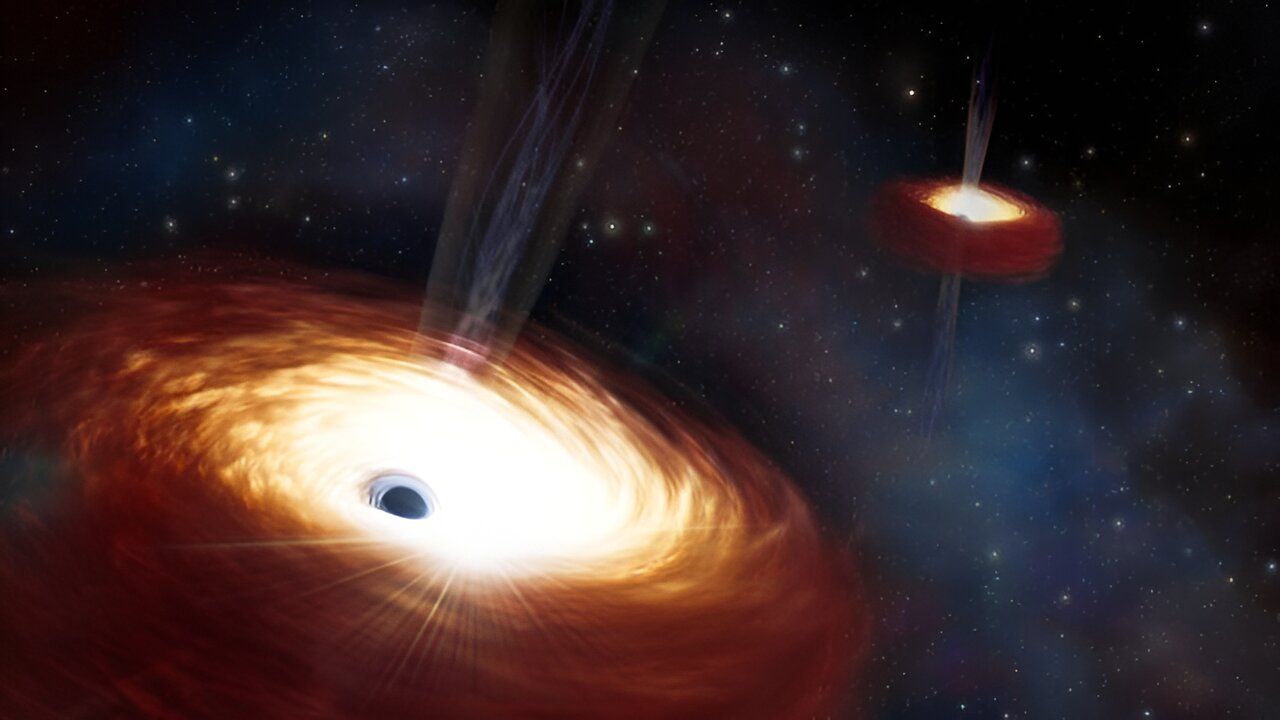The secrets behind the heaviest pair of black holes ever discovered
Follow us on Google News (click on ☆)
These cosmic giants are located in an fossil galaxy named B2 0402+379, and are situated only 24 light-years apart from each other. Despite this extreme proximity, they are engaged in a never-ending orbital dance, without getting any closer, a cosmic ballet that has been ongoing for over 3 billion years.

Artist's illustration of the two supermassive black holes.
Credit: NOIRLab/NSF/AURA/J. daSilva/M. Zamani
Black holes stem from the collapse of gigantic stars and increase their mass by capturing anything that passes close by, whether it be gas, dust, stars, or other black holes. How the very first black holes appeared, however, remains a mystery.
Simulations of the "cosmic dawn," that is, the first few billion years of the Universe, suggest that black holes were born from dense clouds of cold gas and dust, which clumped together into massive stars that were fated to collapse rapidly. These primordial black holes then grew, pulling in surrounding gases which collapsed to form the first stars of dwarf galaxies. As the Universe expanded, these black holes quickly merged with others to form supermassive black holes, also forming larger galaxies.
The discovery of this pair of black holes was made possible through archived data collected by the Gemini North telescope in Hawaii. By using a spectrograph to break down starlight into distinct colors, scientists identified lights from stars accelerating around the black holes. The galaxy B2 0402+379, a "fossil cluster," results from the merger of an entire cluster of stars and gas into a single gigantic galaxy.
Researchers estimate that the merger of black holes within merging galaxies is achieved by entering orbit around each other, then gradually getting closer as their dance dissipates angular momentum by accelerating nearby stars (see explanation below). However, this pair of black holes, due to their massive size, seems to have exhausted all suitable material to slow them down, leaving their merger in limbo.
Researchers plan further investigations into the heart of B2 0402+379 to study the amount of gas present, thereby providing additional insight into the potential for a future merger of the supermassive black holes, or if, conversely, they will remain an eternal duo.
The dissipation of angular momentum in systems of supermassive black holes
The concept of angular momentum dissipation is crucial for understanding the evolution of binary supermassive black hole systems and their eventual merger. Angular momentum, in physics, is a measure of how much rotation an object has around a point. In the context of supermassive black holes orbiting each other, it plays a critical role in the dynamics of their interaction.
When two black holes approach each other in a galaxy, they start by mutually attracting due to their strong gravity. Orbiting each other, they form a binary system. However, for these black holes to merge, they first need to get sufficiently close. To do this, the system must lose energy and angular momentum. Angular momentum keeps them in orbit at a certain distance, and without its dissipation, they would continue to spin indefinitely without ever merging.
Angular momentum dissipation can occur in several ways.
A key method in galactic environments involves dynamic interaction with nearby stars. As the orbiting black holes approach the stars of their host galaxy, their gravitational forces disturb the stellar orbits. These interactions can propel some stars at higher speeds, ejecting them from the galactic system, while allowing the black holes to get closer. This process transfers part of the binary system's angular momentum to the nearby stars, thus reducing the total angular momentum of the black holes and allowing a gradual approach.
Another method of angular momentum dissipation, especially relevant at very close distances, is the emission of gravitational waves. When the black holes reach close enough proximity, the intense warping of space-time around them generates gravitational waves that can be energetic enough to carry away a significant portion of the system's energy and angular momentum, allowing the black holes to finally merge.
Angular momentum dissipation is thus a fundamental process enabling supermassive black holes to approach and merge, a phenomenon that has profound implications for our understanding of galaxy evolution and the structure of the Universe.